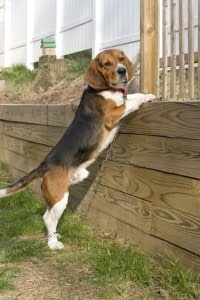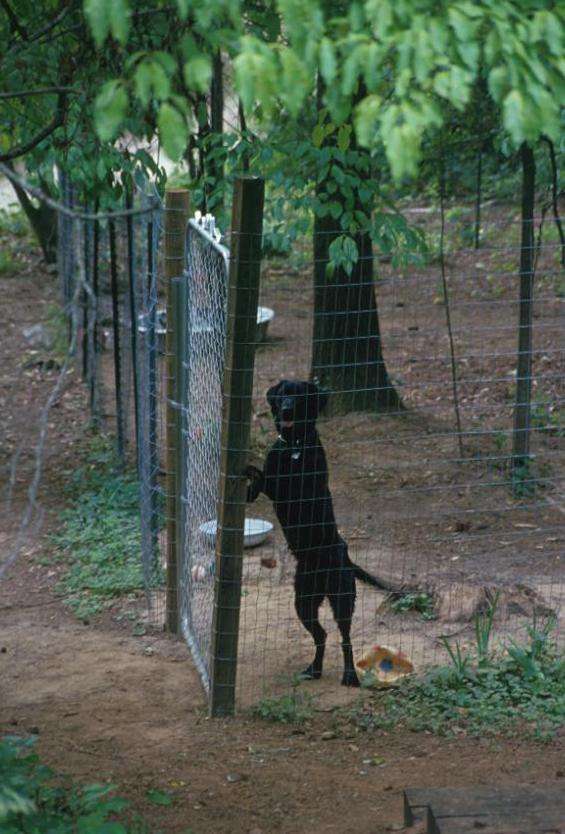When dogs roam, bad things happen – in so many ways.

For instance, aggressive dogs should never be allowed to roam away from home.
For many good reasons, the Brisbane City Council along with many other local authorities, are now looking more seriously at the aggressive dog problem. Lately, it seems that hardly a day goes by without another ghastly dog attack being reported. If you are a dog owner, now, more than ever, you need to examine the way in which you are managing your dog to ensure your pet cannot cause injuries to an innocent person.
I deal with aggressive dogs on a daily basis and the most common problem I see is when dog owners don’t manage their fences and gates effectively.
Escaping and roaming also occurs when dogs are bored or when they have panic disorders such as noise fears.
What is the Perfect Fence?
For a fence to be effective, it needs to be high enough to stop the dog jumping it or climbing it. Mostly, the larger the dog the higher the fence needs to be.
As a general rule, small dogs need a 1.2 metre (chest high) fence, medium dogs a 1.5 metre (shoulder high) fence and large dogs a 1.8 metre (above head high) fence.
Steel colourbond fences are by far the best dog fence. They are impossible to climb, and virtually impenetrable.
Solid wooden fences are also good. For added strength though, ensure the bottom of all boards are double nailed to prevent the dog pushing its way through. Some dogs can use the railings of wooden fences like the rungs of a ladder to aid their escape. This can be easily prevented by covering the railings with a plastic drainage pipe cut in half along the centre to make a hemisphere. This is then nailed over the railing to provide a slippery surface which prevents railings being used as a ‘leg up’ over the fence.
A wooden fence with spaced pickets, also makes a good dog enclosure but there is a significant danger with this type of fence. Dogs which attempt to jump will often get their paws lodged between the pickets at the top of the fence with fatal consequences. Prevent this danger by covering the gap at the top, between each picket, with a narrow, horizontal board, running the entire length of the fence. If the board is placed on the inside of the fence, just below the scalloped top of the paling, it will not be visible.

For those escape artists that continue to jump or climb the fence, the addition of a ‘lean-too’ section on top of the fence, angled at forty-five degrees inwards, is usually effective. This can be made by simply attaching some right-angled shelf brackets to the top of each post and running wire mesh or boards along the top of the shelf brackets. Be sure such additions are above human head height to prevent injury.
Wire mesh fences are suitable for dogs that are not escape artists but they are not the strongest of fences and some dogs can use the mesh as a toe hold to scale the fences.
Many fences are deficient at the base. Undulations of the ground allow the dog to dig under the fence. For aggressive dogs, the inclusion of a concrete footing running the length of the fence is important. This should extend into the ground by at least 30 centimetres.
The Gate Debate

Gates are where problems often occur. With busy families and for those of us with children, it is common for gates to be left ajar and for a dog to escape to the street.
If your dog is also an escape artist, you may find it continually claws and chews at the boundary gates to get out. Most gates are made for humans, not dogs, and have latches at waist level. Dogs, though, work on gates at the base and the leverage action of them clawing and gnawing at the base of the gate eventually fatigues most latches and they break.
For this reason, gats confining all aggressive dogs or escaping dogs must have a barrel bolt installed at the base of the gate. The bolt should extend vertically into a concrete footing at the base of the gate or horizontally to the abutting gate post. The result should be that the bottom of the gate is immovable and appears are invulnerable as the rest of the fence. In this way the dog will lose interest in trying to escape.
For aggressive dogs, all access gates should include automatic closing mechanisms, such as return springs, so that the gate cannot accidentally be left open. Gates should also be locked to prevent pedestrians, especially innocent children, gaining access to the dog.
Driveway gates and garage doors are a common problem. They are so wide, and they are ajar for a long time to allow the family care to pass, providing many daily opportunities for a dog to escape. It is especially risky if the gates or garage doors are operated by a remote button in the car. When approaching home in the car, a dog owner is usually unaware of activities on the street that the family dog might find interesting and, being ‘trapped’ inside the car, the owner is not in a position to quickly control the dog as it romps onto the street through the open gate.
The best option is for the dog to have its own area in the back portion of the garden so that it does not have access to the front garden and to car access points. This allows visitors and cars to pass safely.
If this cannot be managed, then the dog should be tethered or confined elsewhere when visitors or vehicles are entering the property
